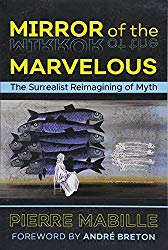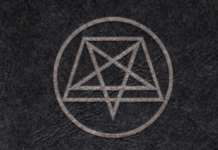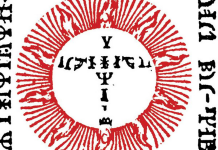Mirror of the Marvelous: The Surrealist Reimaging of Myth, by Pierre Mabille
Inner Traditions, 9781620557334, 320 pp., 2018
Pierre Mabille, long since deceased, has left quite a legacy with his novel Mirror of the Marvelous: The Surrealist Reimagining of Myth. Living through both World Wars, Mabille was primed with emotional intensity that gave way to surrealism in the early 1900s.
Mabille was a scholarly and educated man who worked as a hospital clinic chief and later as a surgeon in Paris. During World War II, he was moved to Haiti where he served as the cultural advisor to the French Embassy. During his time in Haiti, Mabille had the chance to attend Vodou ceremonies. After being relieved of his duties in Haiti the following year, Mabille resumed life in Paris, where he died a few years later at the fairly young age of 48. Drawn to a mythic life, Mabille spent his time studying a magnitude of occult text, medical literature, psychology and philosophy, which gives his writing a depth and flavour reflective of his passion for inquiry.
From his writing in Mirror of the Marvelous, it is quite evident that Mabille was an unconfined thinker who had a highly articulate way with words, and was capable of transporting others into the mystery of terrain he cognitively ventured towards in his pursuit of transcendent truths. In this book, Mabille sets out to explore the marvellous in the world, that which “evokes all the extraordinary and unbelievable phenomena that together constitute the essential domain of fantasy.”1 Mabille explains how the root of the word “marvellous” stems from mirabilia, which comes from “mirror.” As we explore ourselves through the mirror and imagery brought to life through mythic tales, magical texts, and particularly folklore, we reawaken the inherent sensibilities that allow us to open the door to the marvellous and move beyond the veiled box of reality.
Mabille does not venture into this quest naively. He acknowledges the obstacles that an initiate must pass through in order to emerge on the other side. The book is divided into eight chapters. Beginning with “Creation,” Mabille offers literature that tends the flame of surrealist imagery involving the play and power involved in manifestation, invoking possibilities beyond reality for the way in which things come into being and the origins of humanity. The following chapter is “Destruction of the World,” followed by “Crossing Through the Elements,” and “Crossing Through Death,” in which Mabille takes the voyager deeper in the sublime aspects of psychic and cosmic forces of decay, decimation and dismantlement. The following two chapters are “The Marvelous Voyage” and “Predestination,” at which point Mabille calls forth the concept of destiny, and questions whether we seek destiny, or it waits for us. The final chapter, “In Quest of the Grail,” leads back to the heart of romance, death defying sublimation love, which lies at the heart of many mystical quests.
Upholding and valuing the inclination of humanity towards fantasy, Mabille has combined his questioning, analytic nature with the world of the mythic to bring forth this perpetually inspiring way of viewing the stories told through time. Mabille looks at the stories that have emerged from the tension and mystery of human life. Mabille writes, “They are the innovators who continue the great adventure. By listening most attentively to their unconscious, they can better hear the voice of the universe and so hope to extend the domain of the collective marvellous.”2 Times of revolution and uncertainty have create a place for those willing to serve their own inspiration.
Mirror of the Marvelous: The Surrealist Reimagining of Myth is a mixture of Mabille’s philosophies, which he gained from personal journey into the land of the marvellous, interspersed with more than 50 stories, incantations, legends, tales, and texts drawn from cultures around the world and throughout history. He forgoes the traditional composite of Western literary classics in favour of tapping into the power of myth. He clearly did his due diligence in collecting these stories, as the book becomes almost an archeological novel of the human imagination throughout history. He uses these stories, familiar and powerful to the culture from which they emerged, while also adding his own surrealist philosophy to contextualize the marvellous power held within the myths. Mabille truly has created a map to guide those who dare to travel into unknown realms.
Reading Mirror of the Marvelous absolutely opened up my creativity and sense of wonder in the world. As he writes, “What is strange and bizarre manages to disorient us in such a way that the ordinary boundaries separating us from the world are destroyed.”3 The stories Mabille has collected absolutely engaged my sense of disassociation from the rational and stale world of consensus reality. Most of the tales he tells I not previously encountered. They involve castles filled with roses, those pure of heart searching for a mandrake root, and Egyptian tales of the gods with epic battles between brothers. The whole novel was one page-turning imaginative journey after another.
Mabille’s writing is instructive. It is like he is a professional suggesting how and when to venture into this realm and what to do when you get there. The book is filled with Mabille breaking down what it means to enter the marvellous, just so one knows how to best cultivate this flight into the subliminal realm. At every chance, he urges on the path of individuation, immersed in the desire to break free of social constraint, to enter into the true reality of the mythic realms of the marvellous.
Attaining the marvelous requires that the power and knowledge gradually acquired with age help to extend and nourish the child’s spontaneous thought process, rather than to destroy it. In short, a person remains faithful to his own nature rather than fighting it in order to benefit the artificial social personality he has made himself into.4
There is the occasional tale included which has made its mark it popular culture, like Lewis Carroll’s Through the Looking Glass or Franz Kafka’s The Doctor, yet the majority of the folklore was an awakening to my mythic collection. The way Mabille is able to weave the stories together, interspersed with his own fascinating take on philosophy, make this book essential for one who is interested in the imaginative realms of the human mind. My greatest disappointment was the way the book ended rather abruptly after having taken me so far into this journey. I wish that Mabille had graced the reader with his final thoughts, providing a stronger sense of conclusion to the exquisite journey of the mind he had just guided me through.
I absolutely loved Mirror of the Marvelous: The Surrealist Reimagining of Myth, because it was immensely engaging and thought provoking in a way that stimulated my sense of fantasy and imagination. I felt as thought I was immersed in the experience laid out on the pages. Mabille’s insights are one of a kind and philosophically deep. He works with somewhat obscured themes in the hidden liminal realms that only those with the inclination to seek will find. In this way, it is a true literary treasure. The extent of folklore and other stories comprised in the book is worthy of any academic pursuit, and it is bound to inspire revelation for the reader in a multitude of ways.










